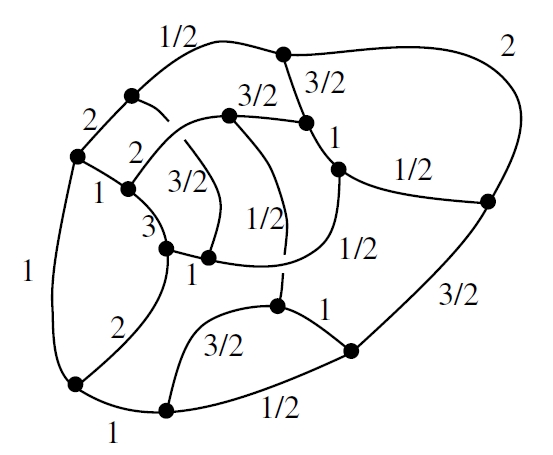
Give us some background on yourself.
I'm interested in all kinds of mathematics and physics, so I call myself a mathematical physicist. But I'm a math professor at the University of California in Riverside. I've taught here since 1989. My wife Lisa Raphals got a job here nine years later: among other things, she studies classical Chinese and Greek philosophy.
I got my bachelors's degree in math at Princeton. I did my undergrad thesis on whether you can use a computer to solve Schrödinger's equation to arbitrary accuracy. In the end, it became obvious that you can. I was really interested in mathematical logic, and I used some in my thesis — the theory of computable functions — but I decided it wasn't very helpful in physics. When I read the magnificently poetic last chapter of Misner, Thorne and Wheeler's Gravitation, I decided that quantum gravity was the problem to work on.
I went to math grad school at MIT, but I didn't find anyone to work with on quantum gravity. So, I did my thesis on quantum field theory with Irving Segal. He was one of the founders of "constructive quantum field theory", where you try to rigorously prove that quantum field theories make mathematical sense and obey certain axioms that they should. This was a hard subject, and I didn't accomplish much, but I learned a lot.
I got a postdoc at Yale and switched to classical field theory, mainly because it was something I could do. On the side I was still trying to understand quantum gravity. String theory was bursting into prominence at the time, and my life would have been easier if I'd jumped onto that bandwagon. But I didn't like it, because most of the work back then studied strings moving on a fixed "background" spacetime. Quantum gravity is supposed to be about how the geometry of spacetime is variable and quantum-mechanical, so I didn't want a theory of quantum gravity set on a pre-existing background geometry!
I got a professorship at U.C. Riverside based on my work on classical field theory. But at a conference on that subject in Seattle, I heard Abhay Ashtekar, Chris Isham and Renate Loll give some really interesting talks on loop quantum gravity. I don't know why they gave those talks at a conference on classical field theory. But I'm sure glad they did! I liked their work because it was background-free and mathematically rigorous. So I started work on loop quantum gravity.
Like many other theories, quantum gravity is easier in low dimensions. I became interested in how category theory lets you formulate quantum gravity in a universe with just 3 spacetime dimensions. It amounts to a radical new conception of space, where the geometry is described in a thoroughly quantum-mechanical way. Ultimately, space is a quantum superposition of "spin networks", which are like Feynman diagrams. The idea is roughly that a spin network describes a virtual process where particles move around and interact. If we know how likely each of these processes is, we know the geometry of space.

Loop quantum gravity tries to do the same thing for full-fledged quantum gravity in 4 spacetime dimensions, but it doesn't work as well. Then Louis Crane had an exciting idea: maybe 4-dimensional quantum gravity needs a more sophisticated structure: a "2-category".
I had never heard of 2-categories. Category theory is about things and processes that turn one thing into another. In a 2-category we also have "meta-processes" that turn one process into another.
I became very excited about 2-categories. At the time I was so dumb I didn't consider the possibility of 3-categories, and 4-categories, and so on. To be precise, I was more of a mathematical physicist than a mathematician: I wasn't trying to develop math for its own sake. Then someone named James Dolan told me about n-categories! That was a real eye-opener. He came to U.C. Riverside to work with me. So I started thinking about n-categories in parallel with loop quantum gravity.
Dolan was technically my grad student, but I probably learned more from him than vice versa. In 1996 we wrote a paper called "Higher-dimensional algebra and topological quantum field theory", which might be my best paper. It's full of grandiose guesses about n-categories and their connections to other branches of math and physics. We had this vision of how everything fit together. It was so beautiful, with so much evidence supporting it, that we knew it had to be true. Unfortunately, at the time nobody had come up with a good definition of n-category, except for n < 4. So we called our guesses "hypotheses" instead of "conjectures". In math a conjecture should be something utterly precise: it's either true or not, with no room for interpretation.
By now, I think everybody more or less believes our hypotheses. Some of the easier ones have already been turned into theorems. Jacob Lurie, a young hotshot at Harvard, improved the statement of one and wrote a 111-page outline of a proof. Unfortunately he still used some concepts that hadn't been defined. People are working to fix that, and I feel sure they'll succeed.

A foam of soap bubbles
Anyway, I kept trying to connect these ideas to quantum gravity. In 1997, I introduced "spin foams". These are structures like spin networks, but with an extra dimension. Spin networks have vertices and edges. Spin foams also have 2-dimensional faces: imagine a foam of soap bubbles.
The idea was to use spin foams to give a purely quantum-mechanical description of the geometry of spacetime, just as spin networks describe the geometry of space. But mathematically, what we're doing here is going from a category to a 2-category.
By now, there are a number of different theories of quantum gravity based on spin foams. Unfortunately, it's not clear that any of them really work. In 2002, Dan Christensen, Greg Egan and I did a bunch of supercomputer calculations to study this question. We showed that the most popular spin foam theory at the time gave dramatically different answers than people had hoped for. I think we more or less killed that theory.
That left me rather depressed. I don't enjoy programming: indeed, Christensen and Egan did all the hard work of that sort on our paper. I didn't want to spend years sifting through spin foam theories to find one that works. And most of all, I didn't want to end up as an old man still not knowing if my work had been worthwhile! To me n-category theory was clearly the math of the future — and it was easy for me to come up with cool new ideas in that subject. So, I quit quantum gravity and switched to n-categories.
But this was very painful. Quantum gravity is a kind of "holy grail" in physics. When you work on that subject, you wind up talking to lots of people who believe that unifying quantum mechanics and general relativity is the most important thing in the world, and that nothing else could possibly be as interesting. You wind up believing it. It took me years to get out of that mindset.
Ironically, when I quit quantum gravity, I felt free to explore string theory. As a branch of math, it's really wonderful. I started looking at how n-categories apply to string theory. It turns out there's a wonderful story here: briefly, particles are to categories as strings are to 2-categories, and all the math of particles can be generalized to strings using this idea! I worked out a bit of this story with Urs Schreiber and John Huerta.
Around 2010, I felt I had to switch to working on environmental issues and math related to engineering and biology, for the sake of the planet. That was another painful renunciation. But luckily, Urs Schreiber and others are continuing to work on n-categories and string theory, and doing it better than I ever could. So I don't feel the need to work on those things anymore — indeed, it would be hard to keep up. I just follow along quietly from the sidelines.
It's quite possible that we need a dozen more good ideas before we really get anywhere on quantum gravity. But I feel confident that n-categories will have a role to play. So, I'm happy to have helped push that subject forward.
Your uncle, Albert Baez, was a physicist. How did he help develop your interests?
He had a huge effect on me. He's mainly famous for being the father of the folk singer Joan Baez. But he started out in optics and helped invent the first X-ray microscope. Later he became very involved in physics education, especially in what were then called third-world countries. For example, in 1951 he helped set up a physics department at the University of Baghdad.
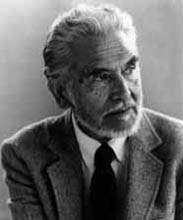
Albert V. Baez
When I was a kid he worked for UNESCO, so he'd come to Washington D.C. and stay with my parents, who lived nearby. Whenever he showed up, he would open his suitcase and pull out amazing gadgets: diffraction gratings, holograms, and things like that. And he would explain how they work! I decided physics was the coolest thing there is.
When I was eight, he gave me a copy of his book The New College Physics: A Spiral Approach. I immediately started trying to read it. The "spiral approach" is a great pedagogical principle: instead of explaining each topic just once, you should start off easy and then keep spiraling around from topic to topic, examining them in greater depth each time you revisit them. So he not only taught me physics, he taught me about how to learn and how to teach.
Later, when I was fifteen, I spent a couple weeks at his apartment in Berkeley. He showed me the Lawrence Hall of Science, which is where I got my first taste of programming — in BASIC, with programs stored on paper tape. This was in 1976. He also gave me a copy of The Feynman Lectures on Physics. And so, the following summer, when I was working at a state park building trails and such, I was also trying to learn quantum mechanics from the third volume of The Feynman Lectures. The other kids must have thought I was a complete geek — which of course I was.
Give us some insight on what your average work day is like.
During the school year I teach two or three days a week. On days when I teach, that's the focus of my day: I try to prepare my classes starting at breakfast. Teaching is lots of fun for me. Right now I'm teaching two courses: an undergraduate course on game theory and a graduate course on category theory. I'm also running a seminar on category theory. In addition, I meet with my graduate students for a four-hour session once a week: they show me what they've done, and we try to push our research projects forward.
On days when I don't teach, I spend a lot of time writing. I love blogging, so I could easily do that all day, but I try to spend a lot of time writing actual papers. Any given paper starts out being tough to write, but near the end it practically writes itself. At the end, I have to tear myself away from it: I keep wanting to add more. At that stage, I feel an energetic glow at the end of a good day spent writing. Few things are so satisfying.
During the summer I don't teach, so I can get a lot of writing done. I spent two years doing research at the Centre of Quantum Technologies, which is in Singapore, and since 2012 I've been working there during summers. Sometimes I bring my grad students, but mostly I just write.
I also spend plenty of time doing things with my wife, like talking, cooking, shopping, and working out at the gym. We like to watch TV shows in the evening, mainly mysteries and science fiction.
We also do a lot of gardening. When I was younger that seemed boring - but as you get older, subjective time speeds up, so you pay more attention to things like plants growing. There's something tremendously satisfying about planting a small seedling, watching it grow into an orange tree, and eating its fruit for breakfast.
I love playing the piano and recording electronic music, but doing it well requires big blocks of time, which I don't always have. Music is pure delight, and if I'm not listening to it I'm usually composing it in my mind.
If I gave in to my darkest urges and becames a decadent wastrel I might spend all day blogging, listening to music, recording music and working on pure math. But I need other things to stay sane.
What research are you working on at the moment?
Lately I've been trying to finish a paper called "Struggles with the Continuum". It's about the problems physics has with infinities, due to the assumption that spacetime is a continuum. At certain junctures this paper became psychologically difficult to write, since it's supposed to include a summary of quantum field theory, which is complicated and sprawling subject. So, I've resorted to breaking this paper into blog articles and posting them on Physics Forums, just to motivate myself.
Purely for fun, I've been working with Greg Egan on some projects involving the octonions. The octonions are a number system where you can add, subtract, multiply and divide. Such number systems only exist in 1, 2, 4, and 8 dimensions: you've got the real numbers, which form a line, the complex numbers, which form a plane, the quaternions, which are 4-dimensional, and the octonions, which are 8-dimensional. The octonions are the biggest, but also the weirdest. For example, multiplication of octonions violates the associative law: (xy)z is not equal to x(yz). So the octonions sound completely crazy at first, but they turn out to have fascinating connections to string theory and other things. They're pretty addictive, and if became a decadent wastrel I would spend a lot more time on them.
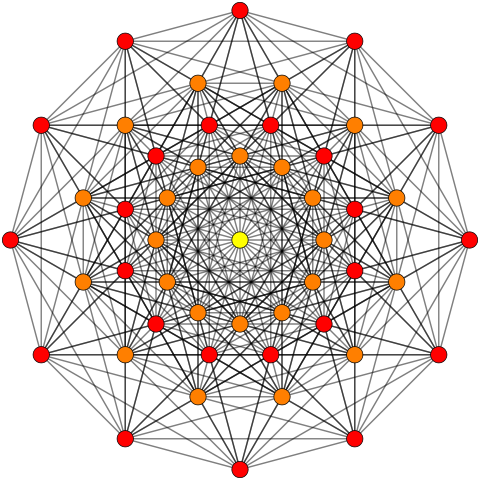
There's a concept of "integer" for the octonions, and integral octonions form a lattice, a repeating pattern of points, in 8 dimensions. This is called the E8 lattice. There's another lattices that lives in in 24 dimensions, called the "Leech lattice". Both are connected to string theory. Notice that 8+2 equals 10, the dimension superstrings like to live in, and 24+2 equals 26, the dimension bosonic strings like to live in. That's not a coincidence! The 2 here comes from the 2-dimensional world-sheet of the string.
Since 3W8 is 24, Egan and I became interested in how you could built the Leech lattice from 3 copies of the E8 lattice. People already knew a trick for doing it, but it took us a while to understand how it worked — and then Egan showed you could do this trick in exactly 17,280 ways! I want to write up the proof. There's a lot of beautiful geometry here.
There's something really exhilarating about struggling to reach the point where you have some insight into these structures and how they're connected to physics.
My main work, though, involves using category theory to study networks. I'm interested in networks of all kinds, from electrical circuits to neural networks to "chemical reaction networks" and many more. Different branches of science and engineering focus on different kinds of networks. But there's not enough communication between researchers in different subjects, so it's up to mathematicians to set up a unified theory of networks.
I've got seven grad students working on this project — or actually eight, if you count Brendan Fong: I've been helping him on his dissertation, but he's actually a student at Oxford.
Brendan was the first to join the project. I wanted him to work on electrical circuits, which are a nice familiar kind of network, a good starting point. But he went much deeper: he developed a general category-theoretic framework for studying networks. We then applied it to electrical circuits, and other things as well.
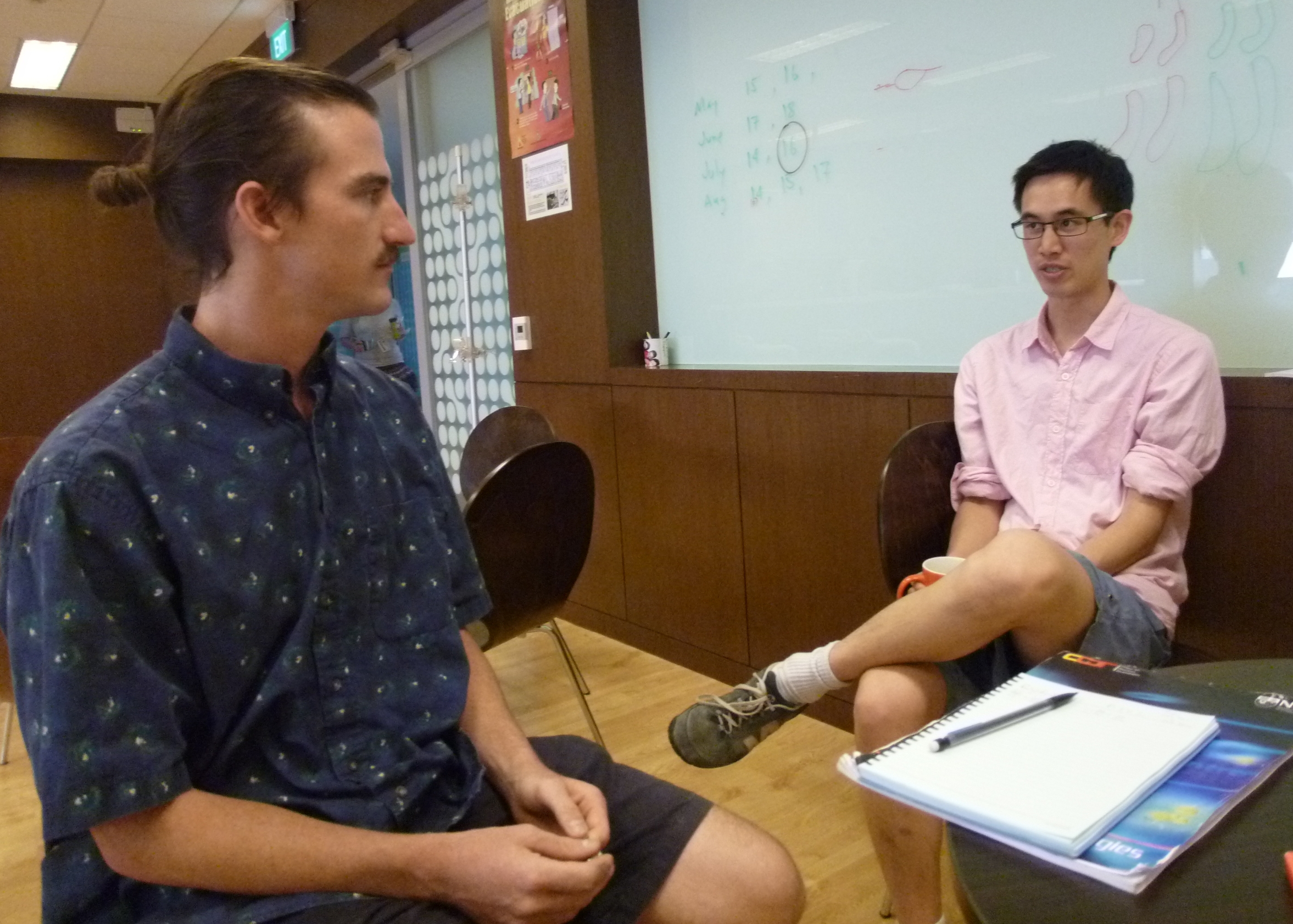
Blake Pollard and Brendan Fong at the Centre for Quantum Technologies
Blake Pollard is a student of mine in the physics department here at U. C. Riverside. Together with Brendan and me, he developed a category-theoretic approach to Markov processes: random processes where a system hops around between different states. We used Brendan's general formalism to reduce Markov processes to electrical circuits. Now Blake is going further and using these ideas to tackle chemical reaction networks.
My other students are in the math department at U. C. Riverside. Jason Erbele is working on "control theory", a branch of engineering where you try to design feedback loops to make sure processes run in a stable way. Control theory uses networks called "signal flow diagrams", and Jason has worked out how to understand these using category theory.
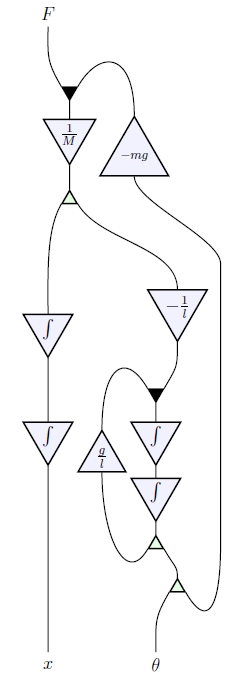
Jason isn't using Brendan's framework: he's using a different one, called PROPs, which were developed a long time ago for use in algebraic topology. My student Franciscus Rebro has been developing it further, for use in our project. It gives a nice way to describe networks in terms of their basic building blocks. It also illuminates the similarity between signal flow diagrams and Feynman diagrams! They're very similar, but there's a big difference: in signal flow diagrams the signals are classical, while Feynman diagrams are quantum-mechanical.
My student Brandon Coya has been working on electrical circuits. He's sort of continuing what Brendan started, and unifying Brendan's formalism with PROPs.
My student Adam Yassine is starting to work on networks in classical mechanics. In classical mechanics you usually consider a single system: you write down the Hamiltonian, you get the equations of motion, and you try to solve them. He's working on a setup where you can take lots of systems and hook them up into a network.
My students Kenny Courser and Daniel Cicala are digging deeper into another aspect of network theory. As I hinted earlier, a category is about things and processes that turn one thing into another. In a 2-category we also have "meta-processes" that turn one process into another. We're starting to bring 2-categories into network theory.
For example, you can use categories to describe an electrical circuit as a process that turns some inputs into some outputs. You put some currents in one end and some currents come out the other end. But you can also use 2-categories to describe "meta-processes" that turn one electrical circuit into another. An example of a meta-process would be a way of simplifying an electrical circuit, like replacing two resistors in series by a single resistor.
Ultimately I want to push these ideas in the direction of biochemistry. Biology seems complicated and "messy" to physicists and mathematicians, but I think there must be a beautiful logic to it. It's full of networks, and these networks change with time. So, 2-categories seem like a natural language for biology.
It won't be easy to convince people of this, but that's okay.
Tell us about your experience with past projects like "This Week's Finds in Mathematical Physics".
I was hired by U.C. Riverside back in 1989. I was lonely and bored, since Lisa was back on the other coast. So, I spent a lot of evenings on the computer.
We had the internet back then — this was shortly after stone tools were invented — but the world-wide web hadn't caught on yet. So, I would read and write posts on "newsgroups" using a program called a "news server". You have to imagine me sitting in front of an old green-on-black cathode ray tube monitor with a large floppy disk drive, firing up the old modem to hook up to the internet.
In 1993, I started writing a series of posts on the papers I'd read. I called it "This Week's Finds in Mathematical Physics", which was a big mistake, because I couldn't really write one every week. After a while I started using it to explain lots of topics in math and physics. I wrote 300 issues. Then I quit in 2010, when I started taking climate change seriously.
Share with us a bit about your current projects like Azimuth and the n-Café.
I've always loved online discussion forums — that's why I liked usenet newsgroups in the old days, and that's why I like Physics Forums now. The n-Category Café is a blog I started with Urs Schreiber and the philosopher David Corfield back in 2006, when all three of us realized that n-categories are the big wave that math is riding right now. We have a bunch more bloggers on the team now. But the n-Café lost some steam when I quit work in n-categories and Urs started putting most of his energy into two related projects: a wiki called the nLab and a discussion group called the nForum.
In 2010, when I noticed that global warming was like a huge wave crashing down on our civilization, I started the Azimuth Project. The goal was to create a focal point for scientists and engineers interested in saving the planet. It consists of a team of people, a blog, a wiki and a discussion group. It was very productive for a while: we wrote a lot of educational articles on climate science and energy issues. But lately I've realized I'm better at abstract math. So, I've been putting more time into working with my grad students. I'm still motivated by environmental issues, but I'm trying to find ways for mathematicians to work on them.
What about climate change has captured your interest?
That's like asking: "What about that huge tsunami rushing toward us has captured your interest?"
Around 2004 I started hearing news that sent chills up my spine — and what really worried me is how few people were talking about this news, at least in the US.
I'm talking about how we're pushing the Earth's climate out of the glacial cycle we've been in for over a million years, into brand new territory. I'm talking about things like how it takes hundreds or thousands of years for CO2 to exit the atmosphere after it's been put in. And I'm talking about how global warming is just part of a bigger phenomenon: the Anthropocene. That's a new geological epoch, in which the biosphere is rapidly changing due to human influences. It's not just the temperature:
This doesn't necessarily spell the end of our civilization, but it is something that we'll all have to deal with.
So, I felt the need to alert people and try to dream up strategies to do something. That's why in 2010 I quit work on n-categories and started the Azimuth Project.

From Global Warming Art
You have life experience on both US coasts. Which do you prefer and why?
There are some differences between the coasts, but they're fairly minor. The West Coast is part of the Pacific Rim, so there's more Asian influence here. The seasons are less pronounced here, because winds in the northern hemisphere blow from west to east, and the oceans serve as a temperature control system. Down south in Riverside it's a semi-desert, so we can eat breakfast in our back yard in January! But I live here not because I like the West Coast more. This just happens to be where my wife Lisa and I managed to get a job.
What I really like is getting out of the US and seeing the rest of the world. When you're at cremation ritual in Bali, or a Hmong festival in Laos, the difference between regions of the US starts seeming pretty small.
But I wasn't a born traveler. When I spent my first summer in England, I was very apprehensive about making a fool of myself. The British have different manners, and their old universities are full of arcane customs and subtle social distinctions that even the British find terrifying. But after a few summers there I got over it. First, all around the world, being American gives you a license to be clueless. If you behave any better than the worst stereotypes, people are impressed. Second, I spend most of my time with mathematicians, who are incredibly forgiving of bad social behavior as long as you know interesting theorems.
By now I've gotten to feel very comfortable in England. The last couple of years I've spent time at the quantum computation group at Oxford — the group run by Bob Coecke and Samson Abramsky. I like talking to Jamie Vicary about n-categories and physics, and also my old friend Minhyong Kim, who is a number theorist there.
I was also very apprehensive when I first visited Paris. Everyone talks about how the waiters are rude, and so on. But I think that's an exaggeration. Yes, if you go to cafés packed with boorish tourists, the waiters will treat you like a boorish tourist — so don't do that. If you go to quieter places and behave politely, most people are friendly. Luckily Lisa speaks French and has some friends in Paris; that opens up a lot of opportunities. I don't speak French, so I always feel like a bit of an idiot, but I've learned to cope. I've spent a few summers there working with Paul-André Melliès on category theory and logic.

Yau Ma Tei Market – Hong Kong
I was also intimidated when I first spent a summer in Hong Kong — and even more so when I spent a summer in Shanghai. Lisa speaks Chinese too: she's more cultured than me, and she drags me to interesting places. My first day walking around Shanghai left me completely exhausted: everything was new! Walking down the street you see people selling frogs in a bucket, strange fungi and herbs, then a little phone shop where telephone numbers with lots of 8's cost more, and so on: it's a kind of cognitive assault.
But again, I came to enjoy it. And coming back to California, everything seemed a bit boring. Why is there so much land that's not being used? Where are all the people? Why is the food so bland?
I've spent the most time outside the US in Singapore. Again, that's because my wife and I both got job offers there, not because it's the best place in the world. Compared to China it's rather sterile and manicured. But it's still a fascinating place. They've pulled themselves up from a British colonial port town to a multi-cultural country that's in some ways more technologically advanced than the US. The food is great: it's a mix of Chinese, Indian, Malay and pretty much everything else. There's essentially no crime: you can walk around in the darkest alley in the worst part of town at 3 am and still feel safe. It's interesting to live in a country where people from very different cultures are learning to live together and prosper. The US considers itself a melting-pot, but in Singapore they have four national languages: English, Mandarin, Malay and Tamil.
Most of all, it's great to live in places where the culture and politics is different than where I grew up. But I'm trying to travel less, because it's bad for the planet.
You've gained some fame for your "crackpot index". What were your motivations for developing it? Any new criteria you'd add?
After the internet first caught on, a bunch of us started using it to talk about physics on the usenet newsgroup sci.physics.
And then, all of a sudden, crackpots around the world started joining in!
Before this, I don't think anybody realized how many people had their own personal theories of physics. You might have a crazy uncle who spent his time trying to refute special relativity, but you didn't realize there were actually thousands of these crazy uncles.
As I'm sure you know here at Physics Forums, crackpots naturally tend to drive out more serious conversations. If you have some people talking about the laws of black hole thermodynamics, and some guy jumps in and says that the universe is a black hole, everyone will drop what they're doing and argue with that guy. It's irresistible. It reminds me of how when someone brings a baby to a party, everyone will start cooing to the baby. But it's worse.
When physics crackpots started taking over the usenet newsgroup sci.physics, I discovered that they had a lot of features in common. The Crackpot Index summarizes these common features. Whenever I notice a new pattern, I add it.
For example: if someone starts comparing themselves to Galileo and says the physics establishment is going after them like the Inquisition, I guarantee you that they're a crackpot. Their theories could be right — but unfortunately, they've got delusions of grandeur and a persecution complex.
It's not being wrong that makes someone a crackpot. Being a full-fledged crackpot is the endpoint of a tragic syndrome. Someone starts out being a bit too confident that they can revolutionize physics without learning it first. In fact, many young physicists go through this stage! But the good ones react to criticism by upping their game. The ones who become crackpots just brush it off. They come up with an idea that they think is great, and when nobody likes it, they don't say "okay, I need to learn more." Instead, they make up excuses: nobody understands me, maybe there's a conspiracy at work, etc. The excuses get more complicated with each rebuff, and it gets harder and harder for them to back down and say "whoops, I was wrong".
When I wrote the Crackpot Index, I thought crackpots were funny. Alexander Abian claimed all the world's ills would be cured if we blew up the Moon. Archimedes Plutonium thinks the Universe is a giant plutonium atom. These ideas are funny. But now I realize how sad it is that someone can start with an passion for physics and end up in this kind of trap. They almost never escape.
Who are some of your math and physics heroes of the past and of today?
Wow, that's a big question! I think every scientist needs to have heroes. I've had a lot.
When I was a kid, I was in love with Marie Curie. I wanted to marry a woman like her: someone who really cared about science. She overcame huge obstacles to get a degree in physics, discovered not one but two new elements, often doing experiments in her own kitchen — and won not one but two Nobel prizes. She was a tragic figure in many ways. Her beloved husband Pierre, a great physicist in his own right, slipped and was run over by a horse-drawn cart, dying instantly when the wheels ran over his skull. She herself probably died from her experiments with radiation. But this made me love her all the more.
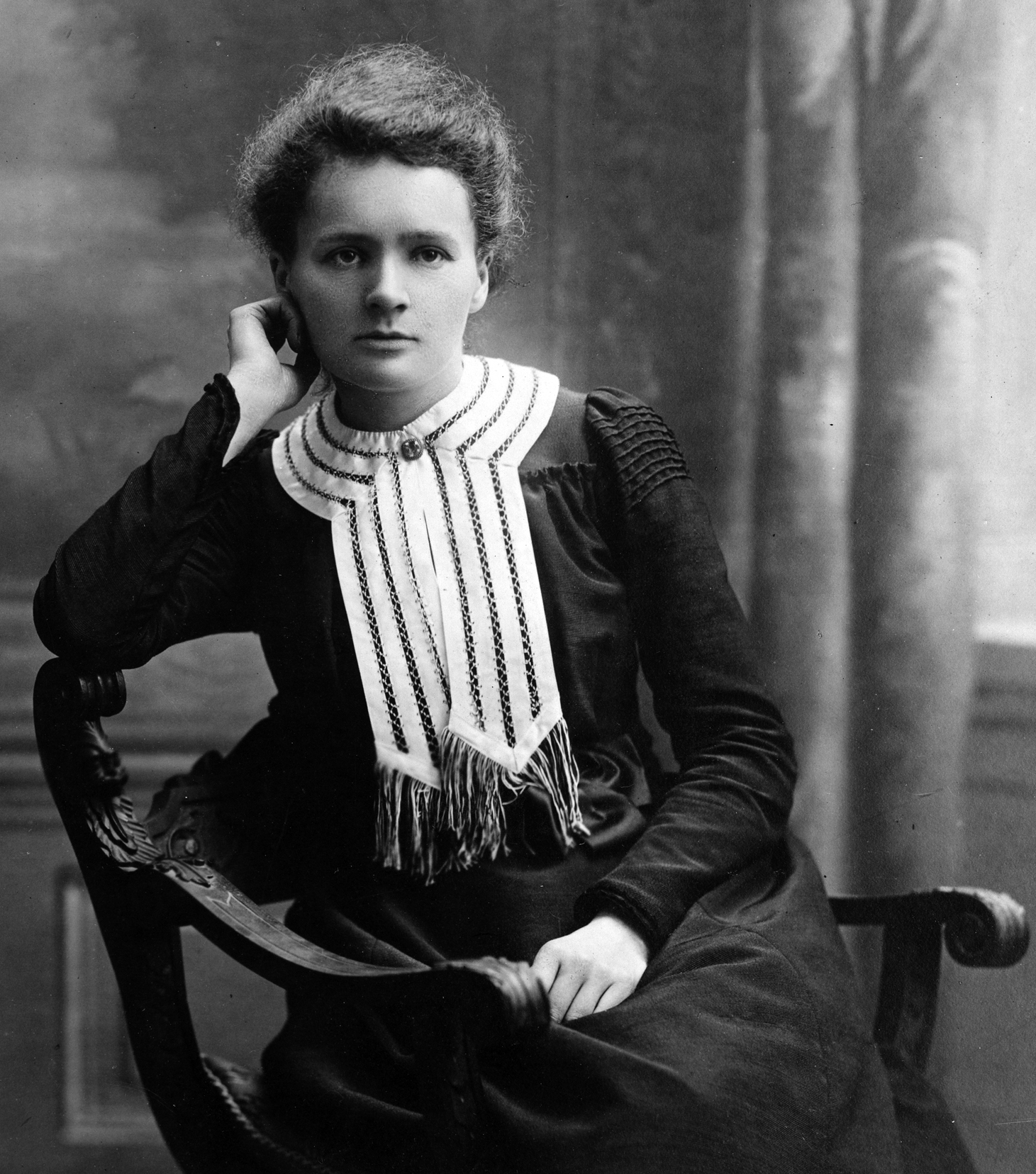
Marie Curie
Later my big hero was Einstein. How could any physicist not have Einstein as a hero? First he came up with the idea that light comes in discrete quanta: photons. Then, two months later, he used Brownian motion to figure out the size of atoms. One month after that: special relativity, unifying space and time! Three months later, the equivalence between mass and energy. And all this was just a warmup for his truly magnificent theory of general relativity, explaining gravity as the curvature of space and time. He truly transformed our vision of the Universe. And then, in his later years, the noble and unsuccessful search for a unified field theory. As a friend of mine put it, what matters here is not that he failed: what matters is that he set physics a new goal, more ambitious than any goal it had before.
Later it was Feynman. As I mentioned, my uncle gave me Feynman's Lectures on Physics. This is how I first learned Maxwell's equations, special relativity, quantum mechanics. His way of explaining things with a minimum of jargon, getting straight to the heart of every issue, is something I really admire. Later I enjoyed his books like Surely You Must Be Joking. Still later I learned enough to be impressed by his work on QED.
But when you read his autobiographical books, you can see that he's trying a bit too hard to convince us that he's a fun-loving ordinary guy. A fun-loving ordinary guy who just happens to be smarter than everyone else. He could also be pretty mean to women — and in that respect, Einstein was even worse. So our heroes should not be admired uncritically.
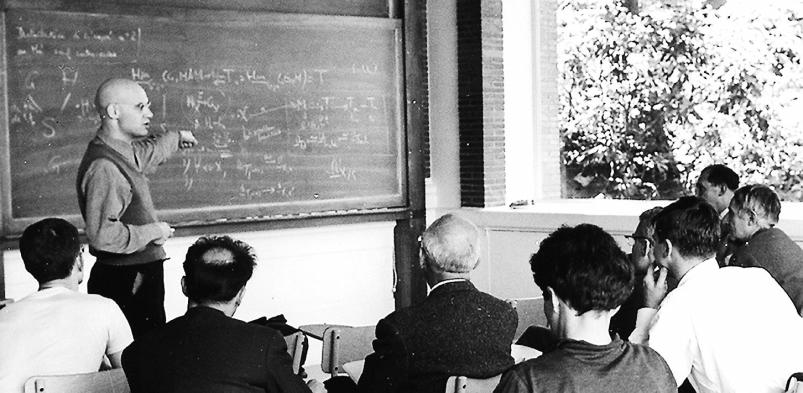
Alexander Grothendieck
A good example is Alexander Grothendieck. I guess he's my main math hero these days. To solve concrete problems like the Weil conjectures, he avoided brute force techniques and instead developed revolutionary new concepts that gently dissolved those problems. And these new concepts turned out to be much more important than the problems that motivated him. I'm talking about abelian categories, schemes, topoi, stacks, things like that. Everyone who really wants to understand math at a deep level has got to learn these concepts. They're beautiful and wonderfully simple — but not easy to master. You have to really change your world view to understand them, just like general relativity or quantum mechanics. You have to rewire your neurons.
At his peak, Grothendieck seemed almost superhuman. It seems he worked almost all day and all night, bouncing his ideas off the other amazing French algebraic geometers. Apparently 20,000 pages of his writings remain unpublished! But he became increasingly alienated from the mathematical establishment and eventually disappeared completely, hiding in a village near the Pyrenees.
Which groundbreaking advances in science and math are you most looking forward to?
I'd really like to see progress in figuring out the fundamental laws of physics. Ideally, I'd like to know the Theory of Everything. Of course, we don't even know that there is one! There could be an endless succession of deeper and deeper realizations to be had about the laws of physics, with no final answer.
If we ever do discover the Theory of Everything, that won't be the end of the story. It could be just the beginning. For example, next we could ask why this particular theory governs our Universe. Is it necessary, or contingent? People like to chat about this puzzle already, but I think it's premature. I think we should find the Theory of Everything first.
Unfortunately, right now fundamental physics is in a phase of being "stuck". I don't expect to see the Theory of Everything in my lifetime. I'd be happy to see any progress at all! There are dozens of very basic things we don't understand.
When it comes to math, I expect that people will have their hands full this century redoing the foundations using ∞-categories, and answering some of the questions that come up when you do this. The crowd working on "homotopy type theory" is making good progress — but so far they're mainly thinking about ∞-groupoids, which are a very special sort of ∞-category. When we do all of math using ∞-categories, it will be a whole new ballgame.
And then there's the question of whether humanity will figure out a way to keep from ruining the planet we live on. And the question of whether we'll succeed in replacing ourselves with something more intelligent — or even wiser.
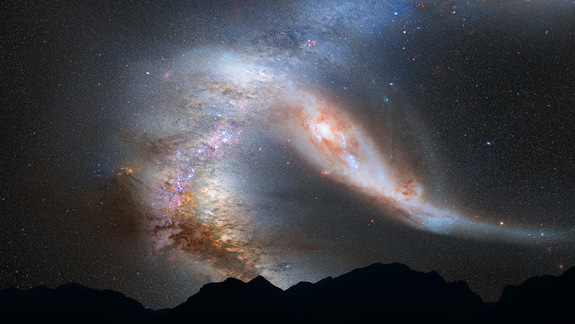
The Milky Way and Andromeda Nebula after their first collision, 4 billion years from now
Here's something cool: red dwarf stars will keep burning for 10 trillion years. If we, or any civilization, can settle down next to one of those, there will be plenty of time to figure things out. That's what I hope for.
But some of my friends think that life always uses up resources as fast as possible. So one of my big questions is whether intelligent life will develop the patience to sit around and think interesting thoughts, or whether it will burn up red dwarf stars and every other source of energy as fast as it can, as we're doing now with fossil fuels.
What does the future hold for John Baez? What are your goals?
What the future holds for me, primarily, is death.
That's true of all of us — or at least most of us. While some hope that technology will bring immortality, or at least a much longer life, I bet most of us are headed for death fairly soon. So I try to make the most of the time I have.
I'm always re-evaluating what I should do. I used to spend time thinking about quantum gravity and n-categories. But quantum gravity feels stuck, and n-category theory is shooting forward so fast that my help is no longer needed.
Climate change is hugely important, and nobody really knows what to do about it. Lots of people are trying lots of different things. Unfortunately I'm no better than the rest when it comes to the most obvious strategies — like politics, or climate science, or safer nuclear reactors, or better batteries and photocells.
The trick is finding things you can do better than other people. Right now for me that means thinking about networks and biology in a very abstract way. I'm inspired by this remark by Patten and Witkamp:
So that's my goal for the next five years or so. It's probably not be the best thing anyone can do to prepare for the Middle Anthropocene. But it may be the best thing I can do: use the math I know to help people understand the biosphere.
It may seem like I keep jumping around: from quantum gravity to n-categories to biology. But some things don't change: I keep thinking about networks, and how they change in time.
At some point I hope to retire and become a bit more of a self-indulgent wastrel. I could write a fun book about group theory in geometry and physics, and a fun book about the octonions. I might even get around to spending more time on music!